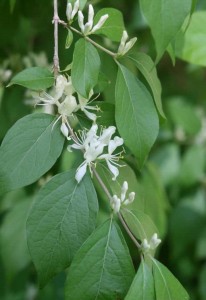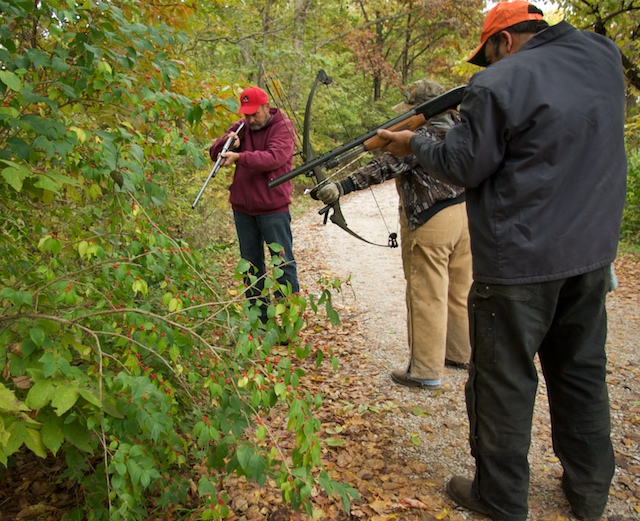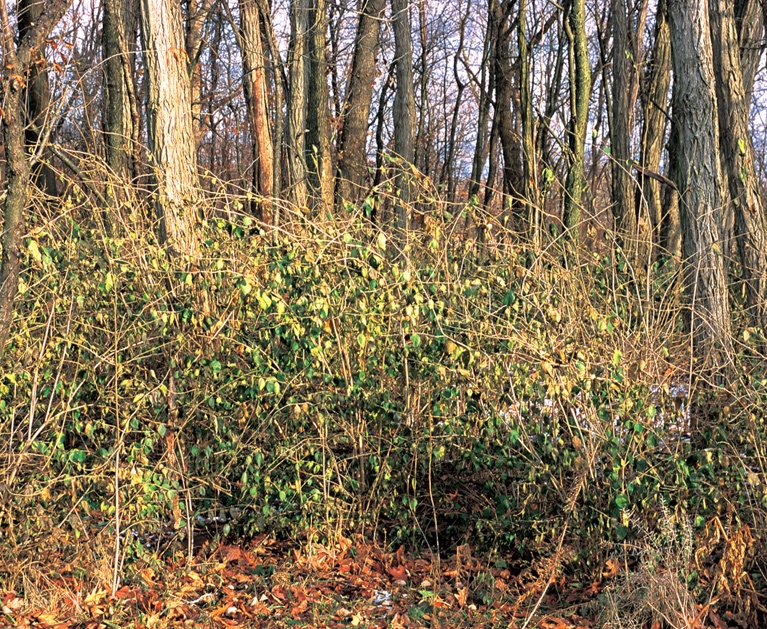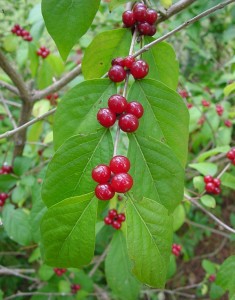Let’s Boot Bush Honeysuckle Off the Land!
The story usually is told as “put a frog in boiling water and he’ll jump out, but put him in water and slowly raise the temperature and he’ll just sit there and cook to death.” While we’re all lots more used to frogs – boiled or not – most of us recognize the camel’s nose as the same sort of story; that is, “once the camel gets his nose in the tent, the rest of him is sure to follow.” Boiled frogs, camels’ noses, slippery slopes: metaphors of warning about failure to notice slowly occurring changes and the terrible consequences that result from lack of awareness.
Such metaphors are attractive and seem to offer a powerful argument. But, frogs DO jump out when the heat makes them uncomfortable no matter how gradually the water is warmed, unless, of course, the experimenter unfairly places a lid on the container or otherwise makes the leap to freedom impossible. The frog doesn’t helplessly slide down a slippery slope of slowly and passively being cooked to death – he “votes with his feet” and makes an exit.
In similar fashion, a number of area residents have decided to fight back against the onslaught of non-native invasive plants and boot them off their lands. The Cooperative Conservation Partnership Initiative between Clifftop and USDA’s Natural Resources Conservation Service (NRCS) is a special program for landowners within the Hill Prairie / Karst Sinkhole Plain. This resource-rich area is the focus area for a special program of NRCS cost-share incentives to landowners to help them steward and care for natural resources and improve wildlife habitat on their lands.
Participants in this program may receive funding to help cover the costs: to have a Certified Forester write a forest management plan; improve timber stands on their property; hire contractors for or retain payments for doing the work of controlling and eradicating non-native invasive plant species; restore rare and declining habitats; and varieties of additional programs to improve wildlife habitat on their landholdings.
Since the start of the CCPI program in late summer 2009, 31 landowners-managers have enrolled nearly 1,800 acres for a variety of cost-share practices. A total of more than $320,000 in funding has been committed to these efforts which will be carried out over a number of years. Much of the work and cost-share dollars are devoted to controlling and removing exotic non-native invasive plants, especially bush honeysuckle.
Each autumn, as area hunters look forward to another season of deer hunting, the honeysuckle problem becomes more apparent. Hunters are wondering how to stalk, how to aim, how to even see their way to a reasonable shot through the “*^^*# (expletives deleted)— DARN honeysuckle!”
Sadly, the short answer to the frustrated hunter is simple: “You’re not.” That is, not if the honeysuckle has formed its own groves, because by then it’s just too dense. Deer do love the thick stuff and often stay there, but not so much because the honeysuckle provides lots of nutritious food. They do browse the plants, but honeysuckle is not a staple food, like oak acorns, and is more a deer form of junk food, filling but not particularly nutrient packed. The structure of honeysuckle thickets, the very twisting, blanketing, all-encompassing tangles, help deer hide from their human predators. Our local landscape shows only too much evidence of honeysuckle monocultures.
Several species of Asian bush honeysuckles are present in the U.S. and all have the same basic story of importation for apparently “good” purposes with unintended and dramatically bad results. Viewed as sweet-smelling, pretty shrubs, bush honeysuckles were imported first to Europe in 1855 and then introduced to the Eastern U.S. in 1896. Widely sold as ornamental plantings, bush honeysuckles also were recommended for additional seemingly beneficial purposes. Since deer browse the vegetation and birds and small mammals eat the prolific red berries, bush honeysuckles were viewed as excellent wildlife plantings, and, because the plants form dense colonies due to root suckering, they also were promoted as a way to control soil erosion.
But these two qualities — tremendous seed production and root generation — coupled with a total lack of controlling predators or diseases in U.S. lands, allowed bush honeysuckle to become one of the most invasive plants on our landscape. As recently as 30 years ago, bush honeysuckles were not known to grow in our area of the state. Time-lapse maps of invasive species show a steady and speedy movement of these plants out of urban areas and into all parts of Illinois.
Bush honeysuckle forms understory thickets that shade out and crowd out the natural regeneration of our native plants. Large colonies of bush honeysuckle are easily viewed along Route 3, especially at wooded areas near Columbia and Waterloo, along Bluff Road, and, sadly, at nearly any wooded area. The totality of impact is dramatic, for once a bush honeysuckle thicket has formed, few other plants are able to grow and reproduce. Bush honeysuckle, like many exotic invasives, creates a monoculture of itself, alone, and transforms a landscape into a desert that gives little sustenance.
Our native oaks and hickories can no longer generate new seedling growth due to the deep shade honeysuckle thickets create. New trees and the future acorn and nut production are therefore reduced. Deer, turkey, quail and a host of other critters that depend on acorns and nuts for food simply run out of food and, where possible, move on, sometimes to adjacent woods and sometimes into yards and gardens. Native wildflowers are shaded out and, lacking enough sunlight to bloom and set seeds, simply die out. Similarly, our native morels and mushrooms cannot maintain colonies without healthy oak-hickory forest areas on which to spread their spores, and are gone forever.
Bush honeysuckle is easily recognized. In fall, its leaves remain green long after native trees and shrubs have dropped their leaves. In spring, bush honeysuckle greens up and leafs out before our native trees and shrubs do. Their ability to green-up earlier and stay green longer gives these invaders an eight to ten week longer growing season — another adaptive advantage which makes bush honeysuckle out-compete our native plants.
Bush honeysuckle is an erect, multi-stemmed semi-evergreen/deciduous shrub with arching branches that can grow 10-20 feet tall. Its leaves are opposite, untoothed, oblong tapering at the tips, and 2-3” long. Fragrant tubular flowers appear in spring and age from white to yellow. Bush honeysuckle berries are red, 1/4 inch in diameter, and appear in May-June. Birds and small mammals eat the berries and help spread the invaders as the seeds are evacuated far from the original plant. The berries, however, are low in fat content compared to our native berries, and provide poor food value to our game and non-game birds and mammals.
There is a simple, surefire field test for ensuring you have identified bush honeysuckle and not confused it with one of our beneficial native plants. Simply cut off a woody twig or branchlet with a scissors or a knife. Bush honeysuckle has hollow pith; our native good guys do not.
There are several management techniques to control and eliminate bush honeysuckle. Smaller specimens, 2 or less feet high, can be easily pulled by two hands. Weed-pullers should take care to disturb the soil as little as possible, since seeds may already be present, and, if berries are on the pulled bushes, the pulled plants should be bagged and removed from the area.
Herbicides are effective in controlling bush honeysuckle. Foliar spraying may be the best method for large-scale, heavy infestations. Use a systemic herbicide such as glyphosate (Roundup) or triclopyr (Garlon, Crossbow, Tahoe) in the manufacturer’s recommended dilution strength, adding surfactant if recommended. Thoroughly wet all the honeysuckles’ leaves. This method is most effective in late September through early November.
The downside of this method is potential damage to other desirable plants and contamination of the watershed. Herbicide drift may kill plants close by. If you use too much of the herbicide, the toxins may pass through the honeysuckles’ roots into the roots of nearby desirable non-target native plants. You need to avoid using herbicides near creeks, wetlands, sinkhole ponds, and the watershed in general. And, foliar spraying does not kill any seeds present on the plants. Finally, the foliar spray method uses the largest amount of expensive herbicide.
An alternate method to eradicate bush honeysuckle is a combination of manual and chemical practices. It’s also the most work, but has the highest success rate with existing colonies of bush honeysuckle.
Simply cut the bush honeysuckle shrubs down to the lowest possible common stem(s) near the ground and then immediately paint, daub or squirt herbicide on the cut stump. Don’t wait to apply the herbicide, because the stump can scab over in less than an hour which prevents herbicide penetration. This method is also most effective in the late September – early November timeframe because sap is moving down to the roots and will help carry the herbicide. Again, any dead bushes with berries should be carefully removed from the area to prevent seed spread.
Finally, bush honeysuckle cannot tolerate fire. But our native oaks and hickories thrive on fire. A prescribed and controlled burn of your woods in late fall or winter will go a long way in managing honeysuckle. Just make certain you conduct a burn in accordance with Illinois’ Prescribed Burn Law.
Full control and eradication of a bush honeysuckle thicket is a multiyear tasking. Unfortunately the seeds can remain viable within the soil for several years and, more unfortunately still, seeds from plants in other areas can still be transported into the area you’ve worked so hard to clear of this tenacious invader.
With effort and with cost-share help landowners in our bluff lands are making a difference. They are not waiting for bush honeysuckle to transform their landscape but are booting it off their grounds and helping wildlife and wildlife habitat remain a part of the great outdoors we share.
And for the hunter — of deer, squirrels, turkey, mushrooms, wildflowers, birdsong or any other woodland experience – putting a target on honeysuckle and starting a campaign of control must become another well-honed autumn tradition, so that the real hunts can continue.
Clifftop, a local nonprofit organization, is focused on preserving and protecting area bluff lands. For more information about invasive plants in our bluffs see that section at our web site www.clifftopalliance.org
Versions of this article appeared in the October 15 2010 and October 21 2011 editions of the Monroe County Independent.
© 2010 all content rights reserved, Clifftop NFP.
Comments are currently closed.




